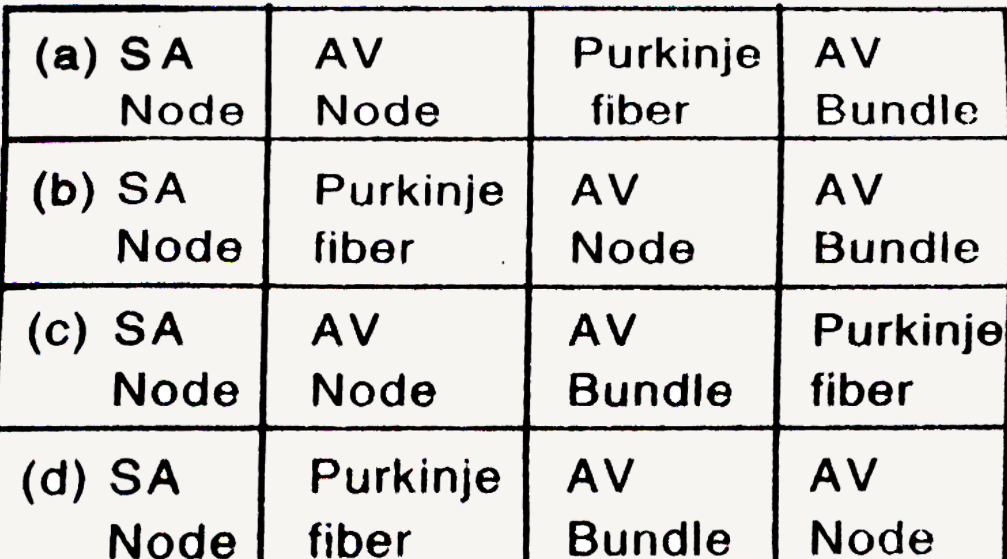The cardiac impulse is initiated and conducted further upto ventricle. The correct sequence of conduction of impulse is
The correct Answer is:C
To understand the conduction of the cardiac impulse up to the ventricles, we can break it down into a step-by-step sequence:
1. Initiation at the Sinoatrial Node (SA Node):
- The cardiac impulse begins at the sinoatrial node (SA node), which is located in the wall of the right atrium, near the opening of the superior vena cava. The SA node is often referred to as the natural pacemaker of the heart because it initiates the electrical impulses that trigger heartbeats.
2. Conduction to the Atrioventricular Node (AV Node):
- Once the SA node generates an impulse, it spreads through the atrial walls, causing the atria to contract. This impulse then reaches the atrioventricular node (AV node), located at the junction between the atria and ventricles.
3. Delay at the AV Node:
- The AV node serves as a critical relay point. It briefly delays the impulse to ensure that the atria have enough time to fully contract and pump blood into the ventricles before the ventricles contract.
4. Transmission through the Atrioventricular Bundle (Bundle of His):
- After the delay, the impulse travels from the AV node down to the atrioventricular bundle (also known as the Bundle of His), which is located in the interventricular septum.
5. Branching into the Right and Left Bundle Branches:
- The Bundle of His splits into two branches: the right bundle branch and the left bundle branch, which run along the interventricular septum towards the apex of the heart.
6. Conduction through Purkinje Fibers:
- The impulse then travels through the Purkinje fibers, which spread throughout the ventricular myocardium. This rapid conduction causes the ventricles to contract almost simultaneously.
7. Ventricular Contraction:
- Finally, the contraction spreads through the ventricular muscle, leading to the pumping of blood from the ventricles into the pulmonary artery and aorta.
Summary of the Sequence:
1. Sinoatrial Node (SA Node)
2. Atrioventricular Node (AV Node)
3. Atrioventricular Bundle (Bundle of His)
4. Right and Left Bundle Branches
5. Purkinje Fibers
6. Ventricular Contraction
- The cardiac impulse begins at the sinoatrial node (SA node), which is located in the wall of the right atrium, near the opening of the superior vena cava. The SA node is often referred to as the natural pacemaker of the heart because it initiates the electrical impulses that trigger heartbeats.
- Once the SA node generates an impulse, it spreads through the atrial walls, causing the atria to contract. This impulse then reaches the atrioventricular node (AV node), located at the junction between the atria and ventricles.
- The AV node serves as a critical relay point. It briefly delays the impulse to ensure that the atria have enough time to fully contract and pump blood into the ventricles before the ventricles contract.
- After the delay, the impulse travels from the AV node down to the atrioventricular bundle (also known as the Bundle of His), which is located in the interventricular septum.
- The Bundle of His splits into two branches: the right bundle branch and the left bundle branch, which run along the interventricular septum towards the apex of the heart.
- The impulse then travels through the Purkinje fibers, which spread throughout the ventricular myocardium. This rapid conduction causes the ventricles to contract almost simultaneously.
- Finally, the contraction spreads through the ventricular muscle, leading to the pumping of blood from the ventricles into the pulmonary artery and aorta.
1. Sinoatrial Node (SA Node)
2. Atrioventricular Node (AV Node)
3. Atrioventricular Bundle (Bundle of His)
4. Right and Left Bundle Branches
5. Purkinje Fibers
6. Ventricular Contraction
Topper's Solved these Questions
- BOOK - NCERT EXEMPLAR ENGLISHCHAPTER - Body Fluids and Circulation EXERCISE - VERY SHORT ANS.TYP.Q12videos
Body Fluids and Circulation
- BOOK - NCERT EXEMPLAR ENGLISHCHAPTER - Body Fluids and Circulation EXERCISE - SHORT ANSWER TYPE QUESTION9videos
Body Fluids and Circulation
- BOOK - NCERT EXEMPLAR ENGLISHCHAPTER - BIOMOLECULES EXERCISE - Long Answer Type Questions5videos
BIOMOLECULES
- BOOK - NCERT EXEMPLAR ENGLISHCHAPTER - BREATHING AND EXCHANGE OF GASESEXERCISE - SATQ7videos
BREATHING AND EXCHANGE OF GASES
Similar Questions
Knowledge Check
- Question 1 - Select One
Saltatory conduction of impulse occurs in
Aliver cellsBnon-myelinated nerve fibresCmyelinated nerve fibresDNone of these
In saltatory conduction of impulse
View SolutionSaltatory conduction of impulse occurs in
View SolutionIdentify the correct sequence of events in a cardiac cycle
View SolutionDescribe the saltatory conduction of nerve impulses.
View SolutionAssertion : The cardiac impulse is said to be myogenic.
Reasoning : The rate of formation and conduction of cardiac impulse can be changed by the action of nerves.View SolutionWhere does cardiac impulse originate. How is it conducted to the rest of the chambers.
View Solution_____ helps in conduction of nerve impulses.
View Solution


